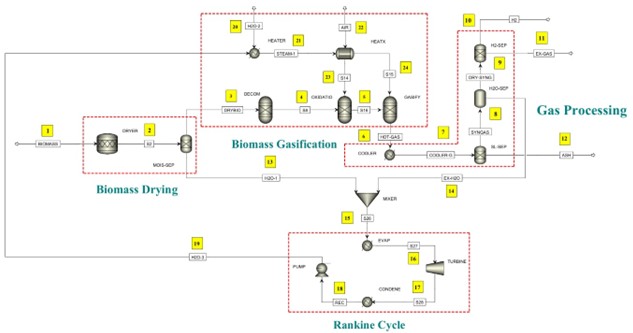Comparative analysis of energy, exergy and economic performance in biomass gasification: a process simulation study
Main Article Content
Abstract
Thailand possesses substantial biomass waste from industrial and agricultural sectors, which can be converted into chemicals and fuel through gasification, a thermochemical process that transforms biomass into fuel gas. This study examined five biomass types: rice straw, rice husks, corn cobs, rubber wood, and sugarcane bagasse, employing thermodynamic, energy, exergy, and economic analyses to assess investment viability through biomass gasification process modeling using ASPEN PLUS V12.1 software. The analysis evaluated the impact of operational variables such as gasification temperature, steam-to-biomass ratio (S/B), and equivalence ratio (ER) on process efficiency. Results indicated that increased gasification temperatures positively affected hydrogen production, with optimal temperatures ranging from 800-900°C, an optimal steam-to-biomass ratio of 1, and an ideal equivalence ratio between 0.1-0.2. Energy and exergy analyses revealed varying equipment efficiencies: decomposition units achieved 54-71% and 38-42%, coolers reached 58-75% and 54-75%, and gasifiers attained 87-96% and 68-76%, respectively, while other equipment exceeded 80% efficiency in both analyses. Economic analysis demonstrated high potential for rice straw, corn cobs, and sugarcane bagasse due to short payback periods and positive Net Present Values (NPV), whereas rice husks proved economically unfavorable with negative NPV and extended payback periods exceeding project timelines. The study's benefits include reduced prototype plant construction costs, improved production planning, and time savings by eliminating trial-and-error approaches in biomass selection for gasification processes.
Article Details

This work is licensed under a Creative Commons Attribution-NonCommercial-NoDerivatives 4.0 International License.
References
Ya-anon T. Climate change action in Thailand: a case study of the 26th session of the conference of the parties to the United Nations Framework Convention on Climate Change. Ramkhamhaeng Law Journal. 2022;11(1):67-108.
Liu X, Zeng Z, Hu G, Asgari A. Thermodynamic, environmental, and economic analysis of a novel power and water production system driven by gas turbine cycle. Alexandria Engineering Journal. 2022;61(12):9529-51. https://doi.org/10.1016/j.aej.2022.03.038.
Pang S. Recent advances in thermochemical conversion of woody biomass for production of green Hydrogen and CO2 capture: a review. Journal of Bioresources and Bioproducts. 2023;8(4):319-32. https://doi.org/10.1016/j.jobab.2023.06.002.
Siri-Anusornsak W, Chula-Laksananukul S, Chula-Laksananukul W. Biogas renewable energy sources (Biogas is a renewable energy). Science Essence Journal. 2011;26(2):197-210.
Gani A, Zaki M, Mamat R, Nizar M, Rosdi SM, Yana S, Sarjono RE. Analysis of technological developments and potential of biomass gasification as a viable industrial process: A review. Case Studies in Chemical and Environmental Engineering. 2023;8:100439. https://doi.org/10.1016/j.cscee.2023.100439.
Chai Y, Packham N, Wang M. Process improvement analysis of pyrolysis/gasification of biomass and waste plastics with carbon capture and utilisation through process simulation. Fuel. 2022;324:124571. https://doi.org/10.1016/j.fuel.2022.124571.
Ranjan N, Yadav N, Singh H, Kumar S, Mahajani SM. Modelling and simulation of autothermal downdraft co-gasification of biomass and plastic wastes using aspen plus. Energy Conversion and Management. 2023;297:117714. https://doi.org/10.1016/j.enconman.2023.117714.
Chan-on P. Syngas Production from Catalytic Co-Gasification of Biomass and Ethanol [Internet]. 2021 [cited 2024 Dec 20]. Chulalongkorn University Theses and Dissertations (Chula ETD). Available from: https://digital.car.chula.ac.th/chulaetd/4985.
Teles MP, Bram MV, Shabani HR, Majidabad SS, Liniger J, Cui X. Optimization and 3E analysis on variable operational conditions of a large, medium and small size Green Methanol Plant. Energy Conversion and Management. 2024;300:117870. https://doi.org/10.1016/j.enconman.2023.117870.
Kombe EY, Lang'at N, Njogu P, Malessa R, Weber CT, Njoka F, Krause U. Process modeling and evaluation of optimal operating conditions for production of hydrogen-rich syngas from air gasification of rice husks using aspen plus and response surface methodology. Bioresource Technology. 2022;361:127734. https://doi.org/10.1016/j.biortech.2022.127734.
Jayah TH, Aye L, Fuller RJ, Stewart DF. Computer simulation of a downdraft wood gasifier for tea drying. Biomass and bioenergy. 2003;25(4):459-69. https://doi.org/10.1016/S0961-9534(03)00037-0.
Striugas N, Zakarauskas K, Džiugys A, Navakas R, Paulauskas R. An evaluation of performance of automatically operated multi-fuel downdraft gasifier for energy production. Applied Thermal Engineering. 2014;73(1):1151-9. https://doi.org/10.1016/j.applthermaleng.2014.09.007.
Turgut HS, Dincer I. Novel hydrogen and biomethanol production from pinecone biomass using an integrated steam gasification system. Energy Conversion and Management. 2024;310:118474. https://doi.org/10.1016/j.enconman.2024.118474.


